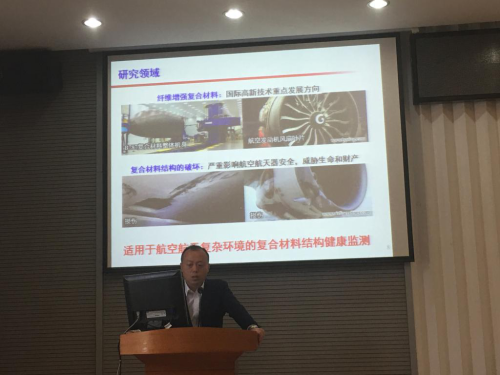On April 17, on invitation by our School, Professor Wu Qi of Nanjing University of Aeronautics and Astronautics delivered a report entitled “Application of Fiber Bragg Grating Ultrasonic Sensing Technology in Aeronautical and Aerospace Structure Monitoring”. Professor Huang Tianye presided over the seminar and teachers and graduate students of our School attended the seminar.
Wu Qi, Professor of Nanjing University of Aeronautics and Astronautics, candidate of national high-level youth talents program, distinguished professor of Jiangsu Province, permanent member of State Key Laboratory of Mechanics and Control of Mechanical Structures, has presided over general program of NSFC, youth program, international exchange and cooperation projects, and independent projects of State Key Laboratory, and has participated in more than ten large-scale scientific research projects such as EU clean aviation and Japanese supercomputer as a key researcher. He has published 31 SCI papers and 14 EI papers in authoritative journals in his research fields; invited by honorary professor Langley of NASA to participate in writing monographs on aviation structural health monitoring; been granted 5 international patents and 2 Chinese invention patents; reported the research results at more than 30 international conferences; won three academic honors; and serve as the reviewer of 40 SCI journals.

The damage of composite structure will seriously affect the safety of aircraft, so structural monitoring is an important research topic in the field of aerospace. However, the existing fiber Bragg grating sensor and ultrasonic guided wave sensor can’t satisfy the high requirements for monitoring of aerospace composite and structure. In the report, he introduced the useful efforts made by the research group in structure forming, small damage evaluation and service monitoring for carbon fiber composites. The high performance FBG ultrasonic sensor technology was adopted to characterize the damage of composite material and realize the health detection of the composite structure. After the report, teachers and students of the School exchanged views with Professor Wu on passive and active ultrasonic sensing technology, and discussed whether composite materials can be detected by infrared method, and whether the dynamic range would be affected by phase-shift grating. Finally, Professor Wu encouraged students to engage in the national aerospace industry, to enhance the core competitiveness of our country.